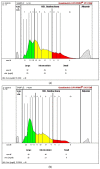Subpopulations of High-Density Lipoprotein: Friends or Foes in Cardiovascular Disease Risk in Chronic Kidney Disease?
- PMID: 34065648
- PMCID: PMC8157071
- DOI: 10.3390/biomedicines9050554
Subpopulations of High-Density Lipoprotein: Friends or Foes in Cardiovascular Disease Risk in Chronic Kidney Disease?
Abstract
Dyslipidemia is a major traditional risk factor for cardiovascular disease (CVD) in chronic kidney disease (CKD) patients, although the altered lipid profile does not explain the number and severity of CVD events. High-density lipoprotein (HDL) is a heterogeneous (size, composition, and functionality) population of particles with different atherogenic or atheroprotective properties. HDL-cholesterol concentrations per se may not entirely reflect a beneficial or a risk profile for CVD. Large HDL in CKD patients may have a unique proteome and lipid composition, impairing their cholesterol efflux capacity. This lack of HDL functionality may contribute to the paradoxical coexistence of increased large HDL and enhanced risk for CVD events. Moreover, CKD is associated with inflammation, oxidative stress, diabetes, and/or hypertension that are able to interfere with the anti-inflammatory, antioxidative, and antithrombotic properties of HDL subpopulations. How these changes interfere with HDL functions in CKD is still poorly understood. Further studies are warranted to fully clarify if different HDL subpopulations present different functionalities and/or atheroprotective effects. To achieve this goal, the standardization of techniques would be valuable.
Keywords: HDL functionality; HDL subpopulations; cardiovascular disease risk; chronic kidney disease; inflammation; oxidative stress.
Conflict of interest statement
The authors declare no conflict of interest.
Figures


References
-
- Liu M., Li X.-C., Lu L., Cao Y., Sun R.-R., Chen S., Zhang P.-Y. Cardiovascular disease and its relationship with chronic kidney disease. Eur. Rev. Med. Pharmacol. Sci. 2014;18:2918–2926. - PubMed
Publication types
Grants and funding
- Norte-01-0145-FEDER-000024/North Portugal Regional Coordination and Development Commission (CCDR-N)/NORTE2020/Portugal 2020
- UIDP/04378/2020 and UIDB/04378/2020/Applied Molecular Biosciences Unit (UCIBIO), financed by national funds from FCT
- UIDP/04539/2020 (CIBB) and PTDC/SAU-NUT/31712/2017/FCT
- PO-CI-01-0145-FEDER-007440/FEDER/COMPETE
- CENTRO-01-0145-FEDER-000012-HealthyAging2020/CCDR-C/CENTRO2020/Portugal2020
- PTDC/MEC-CAR/31322/2017/Rede de Química e Tecnologia-Associação (REQUIMTE) in the form of a researcher (S. Rocha) - project Dial4Life co-financed by FCT/MCTES
- POCI-01-0145-FEDER-031322/Rede de Química e Tecnologia-Associação (REQUIMTE) in the form of a researcher (S. Rocha) - project Dial4Life co-financed by FEDER/COMPETE 2020
LinkOut - more resources
Full Text Sources

